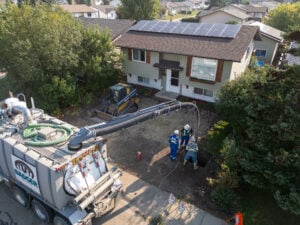The Lai Family
As soon as this challenge got underway, the Lais were hard at work researching what kind of heating systems are feasible for their newly-built home and climate and whether it’s cost effective to replace what they currently use.
They were initially interested in heat pumps, but like the Loewen-Nairs, were startled by the cost. Despite wanting to move away from using their already-installed forced air furnace and natural gas-fueled water heater tank, which is what the vast majority of Ontarians have in their homes, the Lais found the alternatives to be simply unaffordable. “I was not expecting the numbers,” Calvin told Canadian Geographic. “$20,000 for a heat pump unit [and] another 10 grand for a heat pump water heater? These are gigantic numbers.”
However, replacing their heating system in the future is certainly not out of the question. “When my equipment eventually breaks down in 15 years, perhaps I can consider moving to a heat pump,” Calvin said. “But right now, it’s just economically impossible.”
Instead, the Lais made the most out of what they already have for this challenge. For example, they already own an ecobee, which is a smart thermostat that can automatically set temperatures depending on whether they’re home or away. With this, they can heat their house only when needed, resulting in both money and energy saved.










